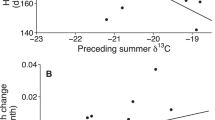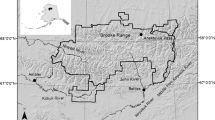Abstract
Variation in life history strategies facilitates the near global distribution of mammals by expanding realized niche width. We investigated physiological plasticity in the spring body composition of adult female brown bears (Ursus arctos) across 4 diverse Alaskan ecosystems. Brown bears are a highly intelligent omnivore with a historic range spanning much of North America, Europe, and Asia. We hypothesized that body mass, fat mass, lean mass, and total caloric content would increase across populations with increasing food resource availability. Throughout their range, brown bears enter a period of torpor during winter months, decreasing their metabolic rate as an adaptation to this period of reduced food availability. They also give birth to and nourish offspring during this time. Due to this specific life history strategy, we further hypothesized that proportional body fat and the proportion of total calories derived from fat would be consistent across populations. Our results supported our first hypothesis: body, fat, and lean masses, and caloric content of bears across populations increased with the quality and abundance of available food. However, the proportional body fat content and proportion of calories from fat differed across populations indicating population-specific strategies to meet the demands of reduced seasonal food availability, offspring production and rearing, and climate as well as some plasticity to respond to environmental change or ecosystem perturbations. Investigations of body condition and energetics benefit from combined assessments of absolute, proportional, and caloric metrics to understand the nuances of brown bear physiological dynamics across and within populations.


Similar content being viewed by others
References
Barboza PS, Parker KL (2008) Allocating protein to reproduction in Arctic reindeer and caribou. Physiol Biochem Zool 81:835–855
Bergmann C (1847) Über die verhältnisse der wärmeökonomie der thiere zu ihrer grösse. Göttinger Studien 3:595–708
Bolnick DI, Svanback R, Fordyce JA, Yang LH, Davis JM, Hulsey CD, Forister ML (2003) The ecology of individuals: incidence and implications of individual specialization. Am Nat 161:1–28
Bowen WD, Iverson SJ, Boness DJ, Oftedal OT (2001) Foraging effort, food intake and lactation performance depend on maternal mass in a small phocid seal. Funct Ecol 15:325–334
Buck CL, Barnes BM (1999) Temperatures of hibernacula and changes in body composition of Arctic ground squirrels over winter. J Mamm 80:1264–1276
Cramer W et al (1999) Comparing global models of terrestrial net primary productivity (NPP): overview and key results. Glob Change Bio 5:1–15
Deacy W, Leacock W, Armstrong JB, Stanford JA (2016) Kodiak brown bears surf the salmon red wave: direct evidence from GPS collared individuals. Ecology 97:1091–1098
Erlenbach J, Rode KD, Raubenheimer D, Robbins CT (2014) Macronutrient optimization and energy maximization determines diets of brown bears. J Mamm 95:160–168
Farley SD, Robbins CT (1994) Development of two methods to estimate body composition of bears. Can J Zool 72:220–226
Farley SD, Robbins CT (1995) Lactation, hibernation, and mass dynamics of American black bears and grizzly bears. Can J Zool 73:2216–2222
Felicetti LA, Robbins CT, Shipley LA (2003) Dietary protein content alters energy expenditure and composition of the mass gain in grizzly bears (Ursus arctos horribilis). Physiol Biochem Zool 76:256–261
Fortin JK, Rode KD, Hilderbrand GV, Wilder J, Farley S, Jorgensen C, Marcot BG (2016) Impacts of human recreation on brown bears (Ursus arctos): a review and a new management tool. PLoS ONE 11:e0141983
Gustine DD, Barboza PS, Lawler JP (2010) Dynamics of body protein and the implications for reproduction in captive muskoxen (Ovibos moschatus) during winter. Physiol Biochem Zool 83:687–697
Harlow HJ (1997) Winter body fat, food consumption and non-shivering thermogenesis of representative spontaneous and facultative hibernators: the white-tailed prairie dog and black-tailed prairie dog. J Therm Bio 22:21–30
Hertel AG, Bischof R, Langval O, Mysterud A, Kindberg J, Swenson JE, Zedrosser A (2017) Berry production drives bottom-up effects on body mass and reproductive success in an omnivore. Oikos. https://doi.org/10.1111/oik.04515
Hilderbrand GV (2017) Brown bear spring energetics, Alaska 2014–2016. U.S. Geological Survey data release. https://doi.org/10.5066/F7CZ35ND
Hilderbrand GV, Golden HN (2013) Body composition of free-ranging wolves (Canis lupus). Can J Zool 91:1–6
Hilderbrand GV, Farley SD, Robbins CT (1998) Predicting body condition of bears via two field methods. J Wildl Manage 62:406–409
Hilderbrand GV, Jenkins SJ, Schwartz CC, Hanley TA, Robbins CT (1999a) Effect of seasonal differences in dietary meat intake on changes in body mass and composition in wild and captive brown bears. Can J Zool 77:1623–1630
Hilderbrand GV, Schwartz CC, Robbins CT, Jacoby ME, Hanley TA, Arthur SM, Servheen C (1999b) Importance of meat, particularly salmon, to body size, population productivity, and conservation of North American brown bears. Can J Zool 77:132–138
Hilderbrand GV, Schwartz CC, Robbins CT, Hanley TA (2000) Effect of hibernation and reproductive status on body mass and condition of coastal brown bears. J Wildl Manage 64:178–183
Hilderbrand GV, Gustine DD, Mangipane B, Joly K, Leacock W, Mangipane L, Erlenbach J, Sorum MS, Cameron MD, Belant JL, Cambier T (in press). Body size and lean mass of brown bears across and withing four diverse ecosystems. J Zool
Holm S (1979) A simple sequentially rejective multiple test procedure. Scand J Stat 6:65–70
Hood WR, Oftedal OT, Kunz TH (2006) Variation in body composition of female big brown bats (Eptesicus fuscus) during lactation. J Comp Physiol B 176:807–819
Kuntz R, Kubalek C, Ruf T, Tataruch F, Arnold W (2006) Seasonal adjustment of energy budgets in a large wild mammal, the Przewalski horse (Equus ferus przewalskii) I. Energy intake. J Exper Biol 209:4557–4565
Lafferty DJR, Belant JL, Phillips DL (2015) Testing the niche variation hypothesis with a measure of body condition. Oikos 124:732–740
Lesage L, Crête M, Huot J, Ouellet J (2001) Evidence for a trade-off between growth and body reserves in northern white-tailed deer. Oecologia 126:30–41
López-Alfaro C, Robbins CT, Zedrosser A, Nielsen SE (2013) Energetics of hibernation and reproductive trade-offs in brown bears. Ecol Model 270:1–10
Mangipane LS, Belant JL, Lafferty DJR, Gustine DD, Hiller TL, Colvin ME, Mangipane BA, Hilderbrand GV (2017) Dietary plasticity in a nutrient-rich system does not influence brown bear (Ursus arctos) body condition or denning. Polar Biol. https://doi.org/10.1007/s00300-017-2237-6
Mellish JE, Iverson SJ, Bowen WD (1999) Variation in milk production and lactation performance in grey seals and consequences for pup growth and weaning characteristics. Physiol Biochem Zool 72:677–690
Monahan W B, Rosemartin A, Gerst K L, Fisichelli N A, Ault T, Schwartz M D, Gross J E, Weltzin J F (2016) Climate change is advancing spring onset across the U.S. National park system. Ecosphere 7(10):45.https://doi.org/10.1002/ecs2.1465
Monson DH, Estes JA, Bodkin JL, Siniff DB (2000) Life history plasticity and population regulation in sea otters. Oikos 90:457–468
Monteith KL, Stephenson TR, Bleich VC, Conner MM, Pierce BM, Bowyer RT (2013) Risk-sensitive allocation in seasonal dynamics of fat and protein reserves in a long-lived mammal. J Animal Ecol 82:377–388
Mowat G, Heard DC (2006) Major components of grizzly bear diet across North America. Can J Zool 84:473–489
Oftedal OT (2000) Use of maternal reserves as a lactation strategy in large mammals.”. Proc Nutr Soc 59:99–106
Pasitschniak-Arts M (1993) Mammalian Species: Ursus arctos. The Amer Soc Mammal 493:1–10
Robbins CT (2001) Wildlife Feeding and Nutrition. Academic Press, San Diego
Robbins CT, Fortin JK, Rode KD, Farley SD, Shipley LA, Felicetti LA (2007) Optimizing protein intake as a foraging strategy to maximize mass gain in an omnivore. Oikos 116:1675–1682
Rode KD, Robbins CT (2000) Why bears consume mixed diets during fruit abundance. Can J Zool 78:1640–1645
Schwartz CC, Haroldson MA, White GC (2006) Survival of cub and yearling grizzly bears in the greater Yellowstone ecosystem, 1983–2002. Wildl Monographs 161:18–24
Servheen C. 1999. Bear status survey and conservation action plan. IUCN
Sidak Z (1967) Rectangular confidence region for the means of multivariate normal distributions. J Amer Stat Assoc 62:626–633
Stanek AE, Wolf N, Hilderbrand GV, Mangipane B, Causey D, Welker JM (2017) Seasonal foraging strategies of Alaskan gray wolves in a salmon subsidized ecosystem. Can J Zool 95:555–563
Suring LH, Del Frate G (2002) Spatial analyses of locations of brown bears killed in defense of life or property on the Kenai Peninsula, Alaska, USA. Ursus 13:237–245
Suring LH, Farley SD, Hilderbrand GV, Goldstein MI, Howlin S, Erickson WP (2006) Patterns of landscape use by female brown bears on the Kenai Peninsula, Alaska. J Wildl Manage 70:1580–1587
Taylor WP Jr, Reynolds HV III, Ballard WB (1989) Immobilization of grizzly bears with tiletamine hydrochloride and zolazepam hydrochloride. J Wildl Manage 53:978–981
Wilson RR, Gustine DD, Joly K (2014) Evaluating potential effects of an industrial road on winter habitat of caribou in north-central Alaska. Arctic 67:472–482
Winstanley RK, Buttemer WA, Saunders G (1999) Fat deposition and seasonal variation in body composition of red foxes (Vulpes vulpes) in Australia. Can J Zool 77:406–412
Zar JH (1999) Biostatistical analysis, 4th edn. Prentice Hall, Inc., New Jersey
Zuercher GL, Roby DD, Rexstad EA (1999) Seasonal changes in body mass, composition, and organs of northern red-backed voles in interior Alaska. J Mamm 80:443–459
Acknowledgements
We thank biologists W. Deacy and A. Morehouse, wildlife veterinarian J. Powers, and pilots A. Greenblatt, M. Keller, J. DeCreeft, R. Richotte, C. Cebulski, D. Welty, I. Bedingfield, K. Rees, K. VanHatten, and J. and J. Cummings for their assistance with animal capture and handling. N. Svoboda and three anonymous reviewers provided insightful comments and improved the manuscript. Funding was provided by the National Park Service, U.S. Fish and Wildlife Service, and U.S. Geological Survey. All procedures performed in studies involving animals were in accordance with the ethical standards of the institutions or practice at which the studies were conducted. Use of trade, firm, or product names is for descriptive purposes only and does not imply endorsement by the U. S. Government.
Author information
Authors and Affiliations
Corresponding author
Rights and permissions
About this article
Cite this article
Hilderbrand, G.V., Gustine, D.D., Mangipane, B. et al. Plasticity in physiological condition of female brown bears across diverse ecosystems. Polar Biol 41, 773–780 (2018). https://doi.org/10.1007/s00300-017-2238-5
Received:
Revised:
Accepted:
Published:
Issue Date:
DOI: https://doi.org/10.1007/s00300-017-2238-5




